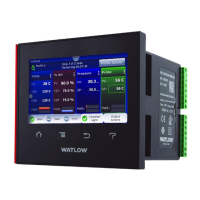Watlow F4T • 75 • Chapter 4 Application Examples
Application Tips:
• The profile engine block is initially located in the library and can be dragged to the
canvas.
• The signal from the input to PV1 on the profile engine lets the profile engine monitor
the process value when guaranteed soak is used and to establish the initial set point
when starting a profile.
• The signal from SP1 on the profile engine to PSP on the control loop allows the profile
engine to control the loop’s set point.
• If you want to be able to have a profile wait for a specific process value, connect the
process value signal to the EVT1 receiver (left side of the profile engine).
• The door switch signal to EVT2 on the profile engine allows profiles to be programmed
to wait for the door to be open or closed.
• The signal from the EVT1 transmitter (right side of the profile engine) to the test acti-
vation output allows the profile to enable an external circuit to power the parts under
test at the appropriate times.
• Enter names for blocks where possible to make the application easier to understand.
Cascade Control
In this example a part is heated in an oven. The part takes a lot longer to heat up than the
heater and oven, and it can be damaged if heated so quickly that the temperature on the sur-
face is a lot higher than the interior temperature. To heat the part in the minimum amount of
time while protecting it from excessive thermal stress, two temperature sensors are used and
the controller is configured for cascade control.

